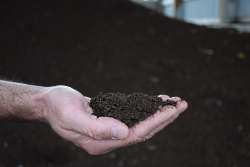
Courtesy NRCS USDA
Analia Bertucci, Photographer
The simple thing to do is to throw all of it into the trash can. But that causes two problems: First, it is an unnecessary addition to landfills. But it is also a waste of natural products that can be used in gardens and fields. The best thing to do is to compost it to use next Spring and Summer. Of course, you can always purchase organic mulch from garden centers, but making your own is free and builds a sense of accomplishment.
So what is composting and how is it done?
Composting is a method to reduce trash in our landfills by allowing natural processes to help decompose plant materials into useful, natural products. Nature has been doing this since plants were first on Earth. And clever gardeners and farmers use that natural process to make rich, organic soils.
We’ve covered the “what and why” questions.
“How” to compost comes next.
- Collect brown, carbon-based materials such as dead leaves, tea and coffee grounds, wood chips, shredded paper, nut shells, etc.
- Add green-waste materials such as fruit peels, grass clippings, vegetable scraps, and garden waste to help in nitrogen production.
- Add water every week to hasten the breakdown of those materials.
- Build your compost pile no larger than 3’ wide, 3’ long, and 3’ high. And place it in a shady spot in your yard with easy access to a hose.
- This material can be placed in ready-made bins you can purchase, or you can build a simple square one out of old wood and chicken wire, or use the corner of your fence. I’m using an unoccupied dog kennel.
- The mixture is important. You should have 3 parts brown matter for every one part green matter.
- To speed up decomposition, mix the materials weekly with a shovel or pitchfork. During cold weather you may see steam coming from the pile. That’s a good sign.
- Now the best part. If you compost during warm weather, it can be ready to add to your lawn or garden in 1 to 3 months.
And it’s important that you do NOT add animal products like meats, dairy, pet waste and eggs. These are the things that will attract flies and create bad odors.
So, avoid adding to our landfills. Build a compost pile and enjoy free supplements to produce beautiful gardens, flower beds, and lawns.
This is Ron Hellstern, and I am Wild About Utah.
Credits:
Images: Courtesy
Text: Ron Hellstern, Cache Valley Wildlife Association
Additional Reading
Liberatore, Andrea, Natures Recyclers, Wild About Utah, November 11, 2011, https://wildaboututah.org/natures-recyclers/
Liberatore, Andrea, Earthworms, Wild About Utah, May 9, 2011, https://wildaboututah.org/earthworms/
Farrell-Poe, Kitt, Koenig, Rich, Backyard Composting in Utah, https://digitalcommons.usu.edu/cgi/viewcontent.cgi?referer=&httpsredir=1&article=1489&context=extension_curall (Reviewed October 2011 by Michael Johnson)
Basic Composting, USU Extension, https://extension.usu.edu/agwastemanagement/ou-files/pdfs/FSBasicsComposting.pdf
Young, Janice, Composting 101, Master Gardener Program, Thanksgiving Point,
https://digitalcommons.usu.edu/cgi/viewcontent.cgi?referer=&httpsredir=1&article=2425&context=extension_histall
Compost Fundamentals, WhatCom County Composting, Washington State University, WhatCom County Extension, https://extension.usu.edu/agwastemanagement/ou-files/pdfs/Compost_Fundamentals.pdf
